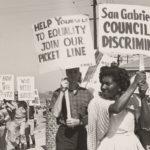 To some, the fight for civil rights in America is an important, but distant, memory.
To some, the fight for civil rights in America is an important, but distant, memory.
According to history books, the struggle to end racial segregation and discrimination in the United States seems complete ― the movement we study ended, scholars write, in 1968, the year President Johnson signed into law the Civil Rights Act, which prohibited racial discrimination in the rental, sale, or financing of housing. But as many, many recent events make clear ― from murders of young black men at the hands of police to a troubling increase in reported hate crimes, the survival of the KKK to the rise of Black Lives Matter ― the fight for civil rights never really came to a close.
A new book titled North of Dixie: Civil Rights Photography Beyond the South, not only aims to remind America that the protests geared toward combatting racial injustice today are hardly removed from the efforts of activists 50 years ago. But also that the friction between civil rights advocates and those who opposed them were never the primary problem of the South. While famous photographers have long focused on those cities plagued by prejudice below the Mason-Dixon Line, historian Mark Speltz is highlighting the images that memorialize the work of progressive freedom fighters in the North.